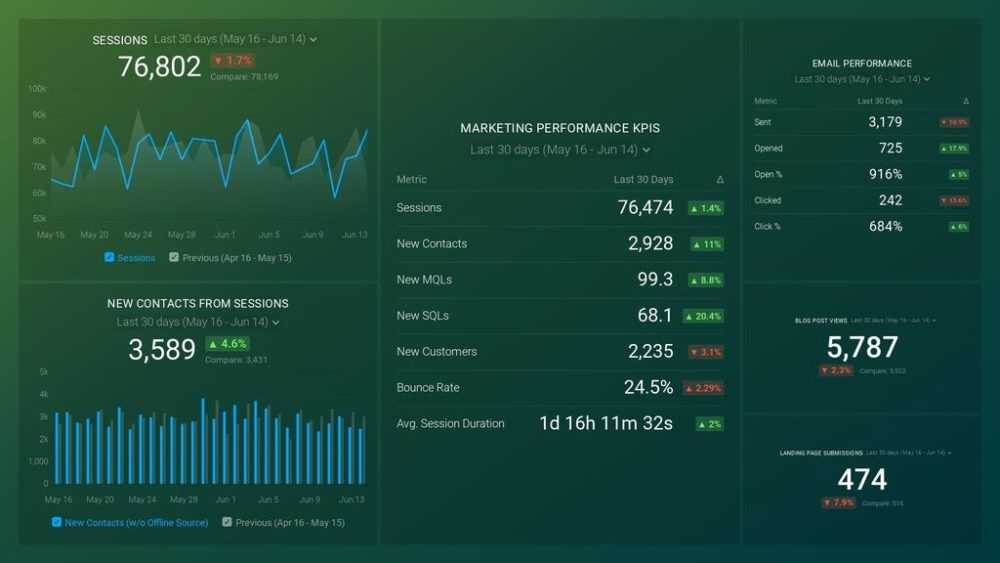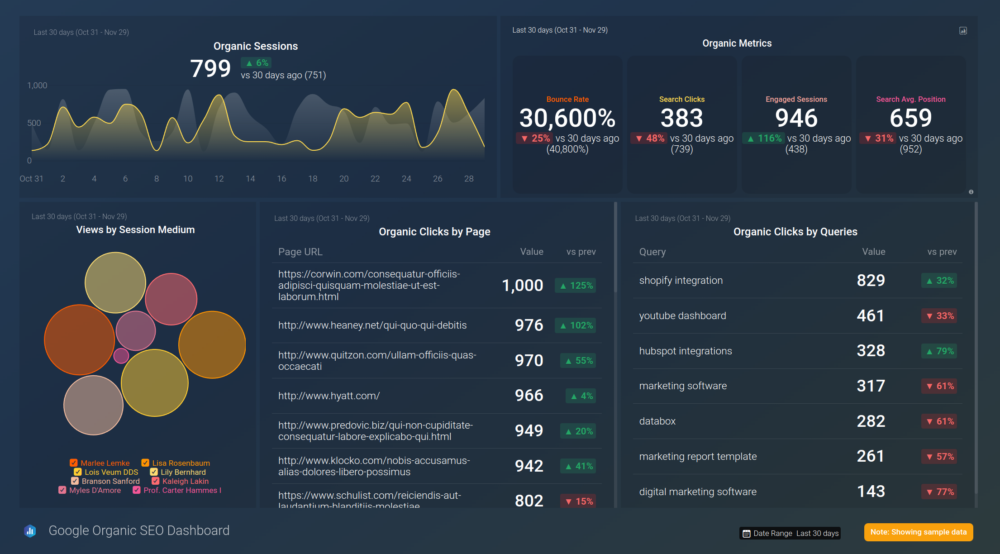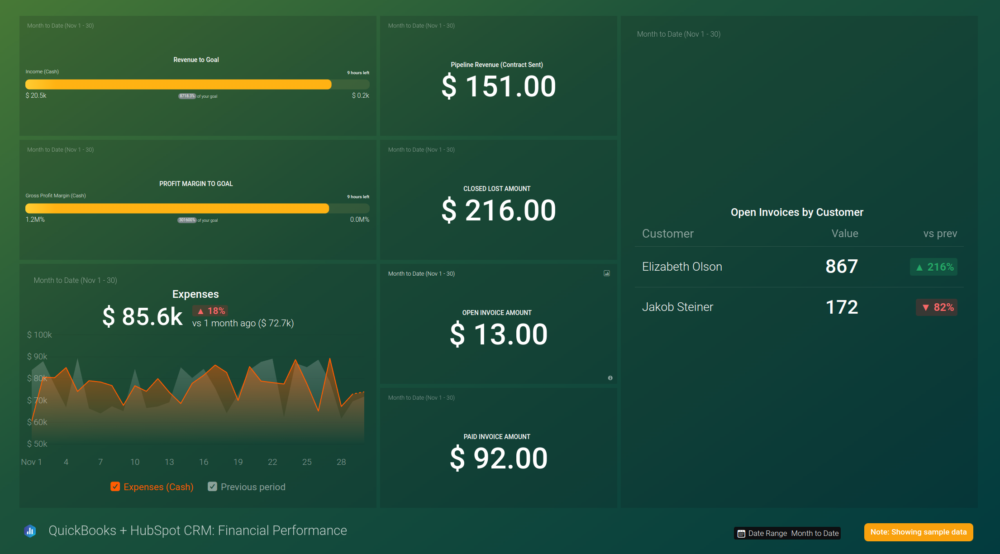Table of contents
Imagine a bunch of bricks. They don’t have a purpose until you put them together into a house, do they?
In business intelligence, data is your building material, and a quality data analysis report is what you want to see as the result.
But if you’ve ever tried to use the collected data and assemble it into an insightful report, you know it’s not an easy job to do. Data is supposed to tell a story about your performance, but there’s a long way from unprocessed, raw data to a meaningful narrative that you can use to create an actionable plan for making steady progress towards your goals.
This article will help you improve the quality of your data analysis reports and build them effortlessly and fast. Let’s jump right in.
- What Is a Data Analysis Report?
- Why Is Data Analysis Reporting Important?
- How to Write a Data Analysis Report? 9 Simple Steps
- Data Analysis Report Examples
What Is a Data Analysis Report?
A data analysis report is a type of business report in which you present quantitative and qualitative data to evaluate your strategies and performance. Based on this data, you give recommendations for further steps and business decisions while using the data as evidence that backs up your evaluation.
Today, data analysis is one of the most important elements of business intelligence strategies as companies have realized the potential of having data-driven insights at hand to help them make data-driven decisions.
Just like you’ll look at your car’s dashboard if something’s wrong, you’ll pull your data to see what’s causing drops in website traffic, conversions, or sales – or any other business metric you may be following. This unprocessed data still doesn’t give you a diagnosis – it’s the first step towards a quality analysis. Once you’ve extracted and organized your data, it’s important to use graphs and charts to visualize it and make it easier to draw conclusions.
Once you add meaning to your data and create suggestions based on it, you have a data analysis report.
A vital detail everyone should know about data analysis reports is their accessibility for everyone in your team, and the ability to innovate. Your analysis report will contain your vital KPIs, so you can see where you’re reaching your targets and achieving goals, and where you need to speed up your activities or optimize your strategy. If you can uncover trends or patterns in your data, you can use it to innovate and stand out by offering even more valuable content, services, or products to your audience.
Why Is Data Analysis Reporting Important?
Data analysis is vital for companies for several reasons.
A reliable source of information
Trusting your intuition is fine, but relying on data is safer. When you can base your action plan on data that clearly shows that something is working or failing, you won’t only justify your decisions in front of the management, clients, or investors, but you’ll also be sure that you’ve taken appropriate steps to fix an issue or seize an important opportunity.
A better understanding of your business
According to Databox’s State of Business Reporting, most companies stated that regular monitoring and reporting improved progress monitoring, increased team effectiveness, allowed them to identify trends more easily, and improved financial performance. Data analysis makes it easier to understand your business as a whole, and each aspect individually. You can see how different departments analyze their workflow and how each step impacts their results in the end, by following their KPIs over time. Then, you can easily conclude what your business needs to grow – to boost your sales strategy, optimize your finances, or up your SEO game, for example.
An additional way to understand your business better is to compare your most important metrics and KPIs against companies that are just like yours. With Databox Benchmarks, you will need only one spot to see how all of your teams stack up against your peers and competitors.
Instantly and Anonymously Benchmark Your Company’s Performance Against Others Just Like You
If you ever asked yourself:
- How does our marketing stack up against our competitors?
- Are our salespeople as productive as reps from similar companies?
- Are our profit margins as high as our peers?
Databox Benchmark Groups can finally help you answer these questions and discover how your company measures up against similar companies based on your KPIs.
When you join Benchmark Groups, you will:
- Get instant, up-to-date data on how your company stacks up against similar companies based on the metrics most important to you. Explore benchmarks for dozens of metrics, built on anonymized data from thousands of companies and get a full 360° view of your company’s KPIs across sales, marketing, finance, and more.
- Understand where your business excels and where you may be falling behind so you can shift to what will make the biggest impact. Leverage industry insights to set more effective, competitive business strategies. Explore where exactly you have room for growth within your business based on objective market data.
- Keep your clients happy by using data to back up your expertise. Show your clients where you’re helping them overperform against similar companies. Use the data to show prospects where they really are… and the potential of where they could be.
- Get a valuable asset for improving yearly and quarterly planning. Get valuable insights into areas that need more work. Gain more context for strategic planning.
The best part?
- Benchmark Groups are free to access.
- The data is 100% anonymized. No other company will be able to see your performance, and you won’t be able to see the performance of individual companies either.
When it comes to showing you how your performance compares to others, here is what it might look like for the metric Average Session Duration:

And here is an example of an open group you could join:

And this is just a fraction of what you’ll get. With Databox Benchmarks, you will need only one spot to see how all of your teams stack up — marketing, sales, customer service, product development, finance, and more.
- Choose criteria so that the Benchmark is calculated using only companies like yours
- Narrow the benchmark sample using criteria that describe your company
- Display benchmarks right on your Databox dashboards
Sounds like something you want to try out? Join a Databox Benchmark Group today!
It makes data accessible to everyone
Data doesn’t represent a magical creature reserved for data scientists only anymore. Now that you have streamlined and easy-to-follow data visualizations and tools that automatically show the latest figures, you can include everyone in the decision-making process as they’ll understand what means what in the charts and tables. The data may be complex, but it becomes easy to read when combined with proper illustrations. And when your teams gain such useful and accessible insight, they will feel motivated to act on it immediately.
Better collaboration
Data analysis reports help teams collaborate better, as well. You can apply the SMART technique to your KPIs and goals, because your KPIs become assignable. When they’re easy to interpret for your whole team, you can assign each person with one or multiple KPIs that they’ll be in charge of. That means taking a lot off a team leader’s plate so they can focus more on making other improvements in the business. At the same time, removing inaccurate data from your day-to-day operations will improve friction between different departments, like marketing and sales, for instance.
More productivity
You can also expect increased productivity, since you’ll be saving time you’d otherwise spend on waiting for specialists to translate data for other departments, etc. This means your internal procedures will also be on a top level.
How to Write a Data Analysis Report? 9 Simple Steps
Want to give value with your data analysis report? It’s critical to master the skill of writing a quality data analytics report. Want to know how to report on data efficiently? We’ll share our secret in the following section.
- Start with an Outline
- Make a Selection of Vital KPIs
- Pick the Right Charts for Appealing Design
- Use a Narrative
- Organize the Information
- Include a Summary
- Careful with Your Recommendations
- Double-Check Everything
- Use Interactive Dashboards
Build automated reports and make better decisions
Report what happened, what changed, then talk about what to do next.
1. Start with an Outline
If you start writing without having a clear idea of what your data analysis report is going to include, it may get messy. Important insights may slip through your fingers, and you may stray away too far from the main topic. To avoid this, start the report by writing an outline first. Plan the structure and contents of each section first to make sure you’ve covered everything, and only then start crafting the report.
2. Make a Selection of Vital KPIs
Don’t overwhelm the audience by including every single metric there is. You can discuss your whole dashboard in a meeting with your team, but if you’re creating data analytics reports or marketing reports for other departments or the executives, it’s best to focus on the most relevant KPIs that demonstrate the data important for the overall business performance.
PRO TIP: How Well Are Your Marketing KPIs Performing?
Like most marketers and marketing managers, you want to know how well your efforts are translating into results each month. How much traffic and new contact conversions do you get? How many new contacts do you get from organic sessions? How are your email campaigns performing? How well are your landing pages converting? You might have to scramble to put all of this together in a single report, but now you can have it all at your fingertips in a single Databox dashboard.
Our Marketing Overview Dashboard includes data from Google Analytics 4 and HubSpot Marketing with key performance metrics like:
- Sessions. The number of sessions can tell you how many times people are returning to your website. Obviously, the higher the better.
- New Contacts from Sessions. How well is your campaign driving new contacts and customers?
- Marketing Performance KPIs. Tracking the number of MQLs, SQLs, New Contacts and similar will help you identify how your marketing efforts contribute to sales.
- Email Performance. Measure the success of your email campaigns from HubSpot. Keep an eye on your most important email marketing metrics such as number of sent emails, number of opened emails, open rate, email click-through rate, and more.
- Blog Posts and Landing Pages. How many people have viewed your blog recently? How well are your landing pages performing?
Now you can benefit from the experience of our Google Analytics and HubSpot Marketing experts through a plug-and-play Databox template. It includes key metrics for tracking your leads and can be used as a standalone dashboard or as part of your marketing reports. You can try it during your free trial no setup headaches.
You can easily set it up in just a few clicks – no coding required.
To set up the dashboard, follow these 3 simple steps:
Step 1: Get the template
Step 2: Connect your HubSpot and Google Analytics 4 accounts with Databox.
Step 3: Watch your dashboard populate in seconds.
3. Pick the Right Charts for Appealing Design
If you’re showing historical data – for instance, how you’ve performed now compared to last month – it’s best to use timelines or graphs. For other data, pie charts or tables may be more suitable. Make sure you use the right data visualization to display your data accurately and in an easy-to-understand manner.
4. Use a Narrative
Do you work on analytics and reporting? Just exporting your data into a spreadsheet doesn’t qualify as either of them. The fact that you’re dealing with data may sound too technical, but actually, your report should tell a story about your performance. What happened on a specific day? Did your organic traffic increase or suddenly drop? Why? And more. There are a lot of questions to answer and you can put all the responses together in a coherent, understandable narrative.
5. Organize the Information
Before you start writing or building your dashboard, choose how you’re going to organize your data. Are you going to talk about the most relevant and general ones first? It may be the best way to start the report – the best practices typically involve starting with more general information and then diving into details if necessary.
6. Include a Summary
Some people in your audience won’t have the time to read the whole report, but they’ll want to know about your findings. Besides, a summary at the beginning of your data analytics report will help the reader get familiar with the topic and the goal of the report. And a quick note: although the summary should be placed at the beginning, you usually write it when you’re done with the report. When you have the whole picture, it’s easier to extract the key points that you’ll include in the summary.
7. Careful with Your Recommendations
Your communication skills may be critical in data analytics reports. Know that some of the results probably won’t be satisfactory, which means that someone’s strategy failed. Make sure you’re objective in your recommendations and that you’re not looking for someone to blame. Don’t criticize, but give suggestions on how things can be improved. Being solution-oriented is much more important and helpful for the business.
8. Double-Check Everything
The whole point of using data analytics tools and data, in general, is to achieve as much accuracy as possible. Avoid manual mistakes by proofreading your report when you finish, and if possible, give it to another person so they can confirm everything’s in place.
9. Use Interactive Dashboards
Using the right tools is just as important as the contents of your data analysis. The way you present it can make or break a good report, regardless of how valuable the data is. That said, choose a great reporting tool that can automatically update your data and display it in a visually appealing manner. Make sure it offers streamlined interactive dashboards that you can also customize depending on the purpose of the report.
Data Analysis Report Examples
To wrap up the guide, we decided to share nine excellent examples of what awesome data analysis reports can look like. You’ll learn what metrics you should include and how to organize them in logical sections to make your report beautiful and effective.
- Marketing Data Analysis Report Example
- SEO Data Analysis Report Example
- Sales Data Analysis Report Example
- Customer Support Data Analysis Report Example
- Help Desk Data Analysis Report Example
- Ecommerce Data Analysis Report Example
- Project Management Data Analysis Report Example
- Social Media Data Analysis Report Example
- Financial KPI Data Analysis Report Example
Marketing Data Report Example
If you need an intuitive dashboard that allows you to track your website performance effortlessly and monitor all the relevant metrics such as website sessions, pageviews, or CTA engagement, you’ll love this HubSpot Marketing Website Overview dashboard template.
SEO Data Analysis Report Example
Tracking the performance of your SEO efforts is important. You can easily monitor relevant SEO KPIs like clicks by page, engaged sessions, or views by session medium by downloading this Google Organic SEO Dashboard.
Sales Data Analysis Report Example
How successful is your sales team? It’s easy to analyze their performance and predict future growth if you choose this HubSpot CRM Sales Analytics Overview dashboard template and track metrics such as average time to close the deal, new deals amount, or average revenue per new client.
Customer Support Analysis Data Report Example
Customer support is one of the essential factors that impact your business growth. You can use this streamlined, customizable Customer Success dashboard template. In a single dashboard, you can monitor metrics such as customer satisfaction score, new MRR, or time to first response time.
Help Desk Data Analysis Report Example
Designed to be intuitive and fully customizable, this HelpScout for Customer Support dashboard template is also customizable and enables you to track the most vital metrics that indicate your customer support agents’ performance: handle time, happiness score, interactions per resolution, and more.
Ecommerce Data Analysis Report Example
Is your online store improving or failing? You can easily collect relevant data about your store and monitor the most important metrics like total sales, orders placed, and new customers by downloading this WooCommerce Shop Overview dashboard template.
Project Management Data Analysis Report Example
Does your IT department need feedback on their project management performance? Download this Jira dashboard template to track vital metrics such as issues created or resolved, issues by status, etc. Jira enables you to gain valuable insights into your teams’ productivity.

Social Media Data Analysis Report Example
Need to know if your social media strategy is successful? You can find that out by using this easy-to-understand Social Media Awareness & Engagement dashboard template. Here you can monitor and analyze metrics like sessions by social source, track the number of likes and followers, and measure the traffic from each source.
Financial KPI Data Analysis Report Example
Tracking your finances is critical for keeping your business profitable. If you want to monitor metrics such as the number of open invoices, open deals amount by stage by pipeline, or closed-won deals, use this QuickBooks + HubSpot CRM Financial Performance dashboard template.
For more advanced financial analysis and automation, platforms like SolveXia can take your reporting a step further. SolveXia is designed specifically for finance teams, offering powerful tools to automate data collection, transformation, reconciliation, and reporting processes. With built-in audit trails, flexible workflows, and real-time dashboards, it helps finance professionals cut down on manual work and focus on high-value analysis.
Rely on Accurate Data with Databox
“I don’t have time to build custom reports from scratch.”
“It takes too long and becomes daunting very soon.”
“I’m not sure how to organize the data to make it effective and prove the value of my work.”
Does this sound like you?
Well, it’s something we all said at some point – creating data analytics reports can be time-consuming and tiring. And you’re still not sure if the report is compelling and understandable enough when you’re done.
That’s why we decided to create Databox dashboards – a world-class solution for saving your money and time. We build streamlined and easy-to-follow dashboards that include all the metrics that you may need and allow you to create custom ones if necessary. That way, you can use templates and adjust them to any new project or client without having to build a report from scratch.
You can skip the setup and build your first dashboard during the free trial, with help from our support team to guide you on which metrics to track and how to structure your dashboard.
Enjoy crafting brilliant data analysis reports that will improve your business – it’s never been faster and more effortless. Sign up today and get your dashboard in no time.























